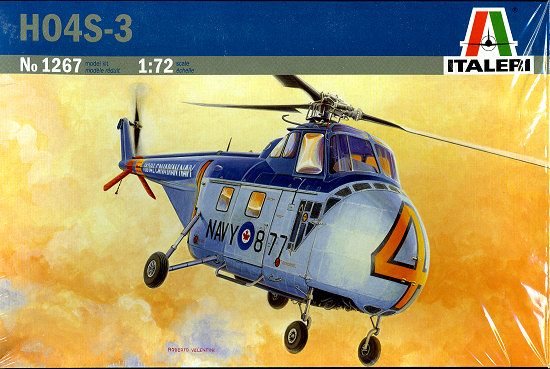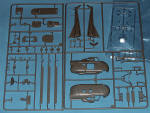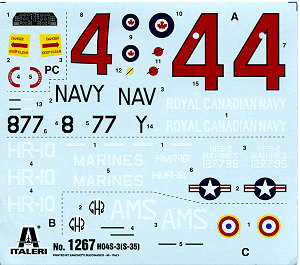
| KIT: | Italeri 1/72 HO4S-3 |
| KIT #: | 1267 |
| PRICE: | $14.95 from GreatModels |
| DECALS: | Three options |
| REVIEWER: | Scott Van Aken |
| NOTES: | Reissue |

| HISTORY |
The H-19's first flight was on November 10, 1949 and it entered operations in 1950. Over 1,000 of the helicopters were manufactured by Sikorsky for the United States. An additional 550 were manufactured by licensees of the helicopter including Westland Aircraft, Sud-Est in France and Mitsubishi in Japan.
The helicopter was widely exported, used by many other nations, including Israel, Chile, South Africa, Denmark and Turkey.
The H-19 underwent live service tests during the Korean War beginning in 1951 as an unarmed transport helicopter. Undergoing tests such as medical evacuation, tactical control and front-line cargo support, the helicopter succeeded admirably in surpassing the capabilities of the H-5 Dragonfly which had been used throughout the Korean conflict by the Army.
In 1956, the French Air Force experimented with arming the H-19 Chickasaw aka Sikorsky S-55, then being superseded in service by the more capable Piasecki H-21 and Sikorsky H-34 helicopters. The H-19 was originally fitted with a 20-mm cannon, two rocket launchers, plus a 20-mm cannon, two 12.7-mm machine guns, and a 7.5-mm light machine gun firing from the cabin windows, but this load proved far too heavy, and even lightly-armed H-19 gunships fitted with flexible machine guns for self-defense proved underpowered.
The H-19 was also used in the early days of the Vietnam War before being supplanted by the Sikorsky H-34 Choctaw, which was based on the H-19.
| THE KIT |
 This is, I believe, the third or so boxing of this kit, not including those done by Revell. The kit comes on two grey and one clear sprue. Detail on the parts is quite good and though I did find ejector pin marks on several, they will be mostly invisible once the kit is built. The main exception are those on the cabin floor, though if you do the door closed, they too will be invisible.
This is, I believe, the third or so boxing of this kit, not including those done by Revell. The kit comes on two grey and one clear sprue. Detail on the parts is quite good and though I did find ejector pin marks on several, they will be mostly invisible once the kit is built. The main exception are those on the cabin floor, though if you do the door closed, they too will be invisible.
Panel lines are lightly engraved while those for access doors are more heavily done. The tail boom is separate from the rest of the body. This is so that Italeri can do different variants, and there is a large blank space on the sprues where those other bits would go. Rotor head detail is nicely done and sufficiently complex to please most. This aircraft will require some nose weight to keep from tail sitting and the large empty nose will h old whatever is required. I did notice that the underside of the fuselage does not match what is shown in the markings drawings and neither does the side winch.
old whatever is required. I did notice that the underside of the fuselage does not match what is shown in the markings drawings and neither does the side winch.
The clear bits are well done and rather thick. As most have compound curves in them, masking them will require some additional thought.
Instructions are well done and provide paint references in Generic, FS 595 and Italeri Model Master references for both enamel and acrylics. There are three markings options and the instructions show what bits are used with what options. I found it interesting that one part is shown as 'not used' yet the drawings and box art all show in in place.
Markings are for three helicopters. One is the box art aircraft from the HMSC Bonaventure in 1953. Another is an all blue USMC HRS-2 in Korea during 1953 and the final marking is for a French H-19 of ALAT GH2 in Algeria during 1956. Decals are well done and should work just fine.
| CONCLUSIONS |
Italeri are the helo kings and this is one of their nicer kits. It isn't so complex that a relatively new modeler will be frustrated and provides enough detail to please most everyone else.
August 2007
You can find this and many other great kits and accessories at GreatModels
If you would like your product reviewed fairly and quickly by asite that has nearly 400,000 visitors a month, please contactme or see other details in the